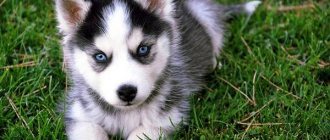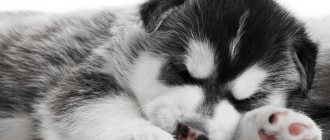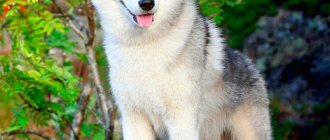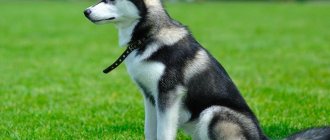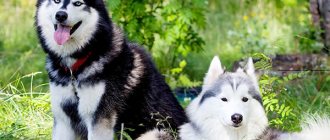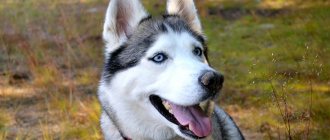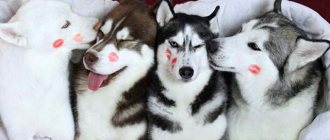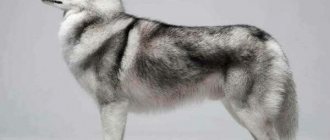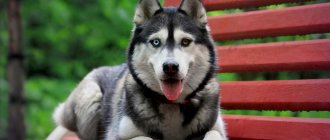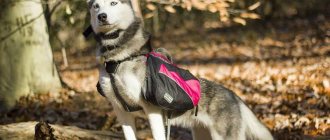Siberian Huskies have become one of the most popular dog breeds in the world, thanks to their beautiful color, soft fluffy coat and deep blue eyes.
Despite their popularity, not everyone knows the origin and true nature of these amazing animals.
Breed card
- Known breed names: Siberian Huskie, Husky, Arctic Husky
- FCI breed number: 270
- Description of the standard on the FCI website: link
- Height at the withers: males - up to 60 cm, females - up to 56 cm
- Weight of an adult dog: males - up to 28 kg, females - up to 23 kg
- Color options: any, from white to black, with characteristic markings on the head
- Lifespan: 12-15 years<
- Puppy cost: from 12,000 to 35,000 rubles
- Size: 4 out of 5
- Learning ability: 3 out of 5
- Attitude towards children: 5 out of 5
- Shedding intensity: 3 out of 5
- Protective and guard qualities: 2 out of 5
Working huskies in the North
The working version of the breed is currently one of the rarest. Huskies have unique working properties, however, due to the low need for use, this type is not very common. In the North, other dogs are used for work. Most often, the working version of the husky is used to transport people for tourism purposes, as well as for sledding competitions.
Characteristic
According to the standard, Huskies belong to the group of northern sled dogs. Known names of the breed are Siberian Husky, Husky, Huskie.
FCI breed standard No. 9
Huskies are strongly built and have well-developed muscles. Males are wide in the chest and loins, females are more slender, but not thin. The line of the back goes smoothly, does not sag, the croup is located just below the withers.
The head of a Siberian dog is of medium size, proportional to the body. The characteristic features of most huskies are blue or multi-colored almond-shaped eyes and a winter brown nose with pink spots. The triangular ears are set high on the head and covered with a dense layer of fur. The ends of the ears point straight up and are slightly rounded. The expression of the muzzle is extremely friendly, perky - sometimes it seems that the dog is smiling.
The husky's tail is "woolly", reminiscent of a fox's. In a calm state it is lowered and reaches the hock joint, and when excited it is raised above the line of the back. A curled tail is considered a defect. The length of the fur at the base of the tail and at the tip is approximately the same. The northern dog moves freely and flexibly, without effort.
At dog shows, judges pay attention to the dog's appearance and movement patterns. Defects include an overly heavy head, a narrow or square muzzle, slanted eyes and overly large ears. Other disadvantages:
- short and thick neck;
- weak sagging back;
- loose paws;
- heavy movements;
- excessively long shaggy coat.
Behavioral defects include cowardice and aggression. A dog found to have any of the defects is immediately excluded from the show.
Husky, Siberian Husky photo, Chukchi Husky sled dog
Dimensions, weight and height of the breed
The height of the dog is measured from the floor to the withers - the highest point on the neck. For males the value is up to 60 cm, and for females – up to 56 cm. The length of the body is slightly greater than the height. Weight fluctuates depending on height, type of diet and physical activity. Siberian Husky males weigh from 20 to 28 kg, females - from 15.5 to 23 kg. Excess weight is a reason for disqualifying a dog from a show.
Possible colors
The undercoat of the Siberian Husky is thick and dense, the guard hair is of medium length, it does not hide the beautiful body of the dog. The fur does not stick out, but lies flat to the body. Colors range from completely black to white, including cream, brown and white-gray. Unusual markings and a mask extending from the nose to the eye area are clearly visible on the husky's head.
Puppy weight by month
Siberian Husky puppies look like fluffy bear cubs. They are not prone to obesity and develop in stages. Weight to age ratio for small huskies:
- 3 months - 11 kg;
- 5 months - 13 kg;
- 8 months - 18 kg;
- 10 months - 18.5 kg;
- 12 months - 20-21 kg.
Lifespan
Huskies live 13-15 years in Russian conditions. In Finland, these dogs successfully live up to 20 years, maintaining excellent health. This is due to the purpose of the breed - Finnish dogs directly perform the functions of sled dogs throughout their lives.
Allergenicity
Siberian Huskies are considered hypoallergenic because they do not smell like “dog.” In fact, this is not true - dandruff accumulates in the thick undercoat, which is the cause of allergies. Before getting a northern dog, take an allergen test and make sure there is no negative reaction.
If the test is positive, you can, of course, get a dog after talking to it first. But you will have to entrust the combing to friends or relatives.
Siberian Husky: photo of the dog, price, description of the breed
Results
The leading features of the Siberian Husky breed are: proportional build, compactness, strong bones and excellent coat, correct set of ears, neck and head, balanced and peaceful disposition.
For a smart person who has the ability to pay enough attention to his pet, this dog will become an irreplaceable, devoted friend and companion.
Did you like the article? Share it with everyone! Thank you!
- Common dog breeds German Shepherd (Deutscher Schaferhund; German Shepherd)
- Working dog breed, Doberman Pinscher (Dobermann)
- Herding and working dog breed Rottweiler
- Dog breed Giant Schnauzer, large
- Dog breed Caucasian Shepherd Dog
- Greater Swiss Shepherd (Grosser Schweizer Sennenhund)
- Briard dog breed and Brie cheese production
- Boxer dog breed (Deutscher Boxer), strength and courage
- Dog breed Great Dane (Great Dane), the largest
- Collie dog breed and the name of the Scottish sheep
- Dog breed Saint Bernard, monk dog
- Newfoundland dog breed, island dog (Newfoundland)
- Dog breed Komondor, home guard and shepherd
- Dog breed English Bulldog
- Dog breed Labrador Retriever
- Dog breed Dachshund (Dachshund), burrowing hunting dog
- Dog breed Fox Terrier and its varieties
- Dog breed Laika (Laika; Russian-European Laika; West Siberian Laika)
- Decorative dog breed Sheltie, mini collie
- Dog breed American Cocker Spaniel, American
- Dog breed Yorkshire Terrier
- Dog breed Pug (Pug), cheerful and loving
- Herding or water dog breed Poodle (Caniche)
- Elegant dog breed Dalmatian or Dalmatian (Dalmatinac)
- Chow-chow dog breed, which has a blue tongue
- Dog breed French bulldog (Bouledogue francais)
- Dog breed Maltese, little miracle
- Pekinese dog breed as an incarnation of Buddha
- Popular breed in Europe: Miniature Schnauzer (Zwergschnauzer)
- Cute and charming dog breed Chihuahua (Chihuahua)
- Dog breed Siberian Husky
- Akita Inu - the treasure of Japan, features and advantages
History of the breed
The word "husky" comes from the Eskimo name "Eski". In the territory of today's Far East of Russia, sled dogs appeared many years before our era. The Aborigines were the first to breed them, and then the Eskimos. They fed the dogs dried fish, of which there was plenty. They were put in teams, 9 per sleigh, and used to transport goods. They didn’t think about breeding and selection in those days.
The impetus for the development of sled dog breeding was given by the Russians who came to Siberia in the 18th century. They needed transport to travel through remote areas of Siberia to collect taxes and transport valuable goods. Large sledges appeared, requiring more dogs in the sled. Representatives of the breed were trained to interact in packs, and breeders selected the best individuals for work.
During the Gold Rush, the need for sled dogs appeared among Americans fishing in the waters of the Sea of Okhotsk. Our neighbors took Alaskan sled dogs to Nome to race. This is how the breed bred in Russia was registered in the USA.
Over time, the racing characteristics of Siberian dogs were not enough for athletes, and they bred a separate breed - Alaskan Huskies.
And Siberian representatives of the breed began to be bred as companions. Huskies became especially widespread when breeders got amazing blue-eyed puppies and fixed this trait.
Dogs returned to Russia only in 1995, and in 1997 a mono-breed exhibition was held, in which 14 huskies took part.
What else can huskies do?
For owners living near forests, they will be excellent guides for forest hiking. Huskies can help their owner carry equipment. These dogs can also be shepherds.
ATTENTION! Huskies are sled dogs. The team and the snow are their nature and element. You can adapt a dog for any purpose, but will such an animal live a full life? It may be worth choosing a breed that suits your goals, lifestyle and character.
Character
Siberian Huskies are friendly, focused on interacting with people, and love to play with children. Very neat and clean.
The working past remains in the character of Siberian dogs to this day - they are tireless and active, they love to drag heavy objects. When buying a husky, remember: she will never become a lazy sofa dog and will require long walks in constant movement.
A bored husky can turn the owner's home into a haven of chaos with piles of things scattered in the corners, chewed furniture legs and torn wallpaper. The dog hunts with pleasure, but does not bring prey. She has fun with small animals and birds on her own.
Basic care
Clean pets of impressive size and owners of luxurious fur. Puppies easily get used to the necessary brushing and bathing.
Regular dental examinations, preventative measures, and ear and eye cleaning are necessary.
Adequate nutrition is the key to health. There is a tendency to overeat. Consultation with a veterinarian is required.
The advantage is considered to be low salivation and excellent immunity. Diseases arise from improper care or from hereditary data. The pet can live up to 15 years.
Education and training
An activity for persistent and self-confident people. To achieve success, especially to protect private households, you will have to work hard.
Education begins with the establishment of behavior in the pack. The time it takes to learn the rules of what is allowed and what is prohibited depends entirely on the owner.
Trust training may be an excellent option for children 12-14 years old, but not earlier.
Learning ability
The initial training of a husky consists of the puppy learning its name and approaching the owner's call. Once your pet has mastered the exercises, introduce more challenging elements.
Huskies are stubborn and difficult to train.
The nuances of properly raising a dog at home on the site:
- In the house, define areas where the puppy is allowed to be and fence them off with drywall.
- Teach your puppy to use a diaper or litter box. After feeding, take him to a place to relieve himself and hold him there for a couple of minutes. If the puppy goes to the toilet, praise it.
- Be consistent in training - having given a command, force the dog to carry it out with the help of treats or mechanical influence.
- Do not punish your child for wrong actions - instead, develop him and methodically practice commands.
Don't allow yourself to shout at your dog - loud noises will make him go into a stupor.
Siberian Husky: photo, description of the breed, character, reviews
How to teach a dog the command to face a person?
First stage of training
- The dog sits next to his left leg, the person holds him by the leash. ...
- The assistant approaches the couple, showing cowardice and waving a rag in front of the animal's face. ...
- Team "Fas!" It is given clearly and loudly when the dog is ready to attack, while the person must lunge forward with his whole body.
Interesting materials:
What is the leavening agent in shortcrust pastry? What is the result of the cross product of two vectors? What are the components of the technological process? What are sporophyte and gametophyte of fern? What comes after mm? What comes after the golden wedding? What comes with 8+? What comes with the iPhone 11 Pro Max? What wheat is prepared for the Navruz holiday? What is made from ebonite?
Attitude towards children
The dog gets along with children of all ages and loves to nurse and play with them. The best example of the interaction between a child and a husky is the birth of a baby among the Eskimos. During this period, all dogs are allowed to move into the home to keep the newborn warm.
Huskies are devoid of aggression, incredibly smart and understand the boundaries of what is permitted. A Siberian dog can harm a baby only by accidentally stepping on or touching it. If there are no experienced dog owners in the family, get a Husky only when you have the time and desire to train your child and dog to interact successfully.
Content
Sled dogs with incredibly beautiful blue eyes are popular today. They are adopted without thinking about the consequences, although it is a bit cramped for a dog in a city apartment.
Need for physical activity
Sled dogs need activity by default. Huskies require a minimum of three and a half hours of active walking per day. She needs to visit new places, explore routes and do physical work that requires endurance.
To throw out the husky's accumulated energy, harness the dog to a sled - it will be happy to give the kids rides.
Representatives of the breed tend to run away - they can break off a leash, break through a window glass or dig a hole under a fence. There are known cases when a husky ran away from its owner simply by smelling a herd of grazing sheep nearby and wanting to get to know them.
The duration of walking pregnant huskies should be at least 20 minutes, 4 times a day. Nursing bitches need to be walked three times a day - 2 times for 10 minutes and 1 time for 20-25 minutes.
Siberian Husky: character, description, photos, puppies, prices
Appearance care
Caring for a husky is easy - its coat is self-cleaning. Even after rolling around in the mud, the dog will look well-groomed and shiny. The Siberian beauty should be bathed no more than once a year, and brushed twice a year. To effectively remove undercoat, use a furminator - it combs out the fur perfectly, while cutting off stray hairs.
In addition to the fur, take care of your dog’s claws and paws - in winter, lubricate the pads with protective wax, and trim the claws with a nail clipper.
Nutrition
Husky is the only dog that can eat fatty pork without harming its liver. If the diets of other breeds are based on a combination of proteins and carbohydrates, then the nutrition of a husky is based on a balance of fats and proteins. Decide what you will feed your dog - ready-made food or natural products. Choose food with the highest fat content possible. Do not believe the “premium class” labels and carefully study the components of the product.
By eating dry food, the dog deprives the body of fluids, so water should be available to it at any time of the day. If you notice that your husky doesn't drink much, feed it pellets soaked in water.
Natural food is of higher quality than sublimates.
However, you will have to consider a balanced diet of the following foods:
- meat;
- buckwheat;
- rice;
- carrot;
- cucumber;
- sea fish.
Do not feed your dog bones or minced meat. Cut pork or beef into large pieces to ensure your Husky's digestion.
Puppies are fed according to a special regime, and after a year, huskies are completely transferred to “adult” food.
Watchdog and security qualities
There are speculations that huskies have absolutely no aggression towards people, they are extremely friendly, and greet strangers cordially.
Lack of response in the security of a private home to thieves. And the education of guards weakens the nervous system, making it dangerous.
The issue of security can be divided into several categories - the protection of territory, a private home, household protection and the protection of a person and his family.
A gregarious breed that has a habitat area protected from strangers. In the north of the country, such a place could be a reindeer herders’ hut in need of protection.
The owner, who had up to ten dogs, created a pack. A well-developed perception of one's own and another's affects security abilities.
They do not bark at strangers, but may growl, flatten their ears and display their front fangs.
The owner's protection is ambiguous, because he must be an authority. Therefore, the dogs themselves have the opportunity to count on protection. A pet can consider its owner’s relatives a member of its pack, placing them lower in rank and protecting them.
The main advantages of the breed include:
- friendly and welcoming manners;
- hardy Siberian health;
- relationship with children and their relatives;
- do not tire with unjustified barking;
- do not have an unpleasant odor.
- Relative disadvantages or disadvantages:
- wayward stubbornness;
- need for leadership;
- the need for training in watchdog skills;
- high shedding;
- urgent need for physical activity.
Huskies were created to be hardy dogs with a need for heavy exercise. Providing long walks and jogs, they are excellent companions for hiking and sledding.
Typical diseases of this breed
Siberian Huskies suffer from hereditary and acquired diseases. When buying a puppy, study the pedigree to check whether the dog has myelopathy, zinc deficiency, or others in the family.
Common diseases:
- glaucoma and retinal atrophy;
- dermatitis is a skin disease;
- myelopathy – a disease of the spinal cord;
- laryngeal paralysis - can only be treated surgically;
- lack of zinc, hence the bald spots on the face.
To avoid panic if you get sick, learn how to provide first aid to your pet.
Husky puppies: description, photos and prices
Buying a puppy
When choosing a husky puppy, determine why you need it - will you harness it to a sleigh or just participate in exhibitions. Siberian dogs don't like to be alone, so if you work a lot, consider a different breed. An overly active puppy spoils things in the absence of the owner.
Buy a puppy at eight weeks of age from breeders who have at least three adult dogs. Puppies raised in the company of their relatives socialize faster. After choosing a litter, observe the movements of the puppies, examine the head, paws and bite of each. Choose one that has no defects.
